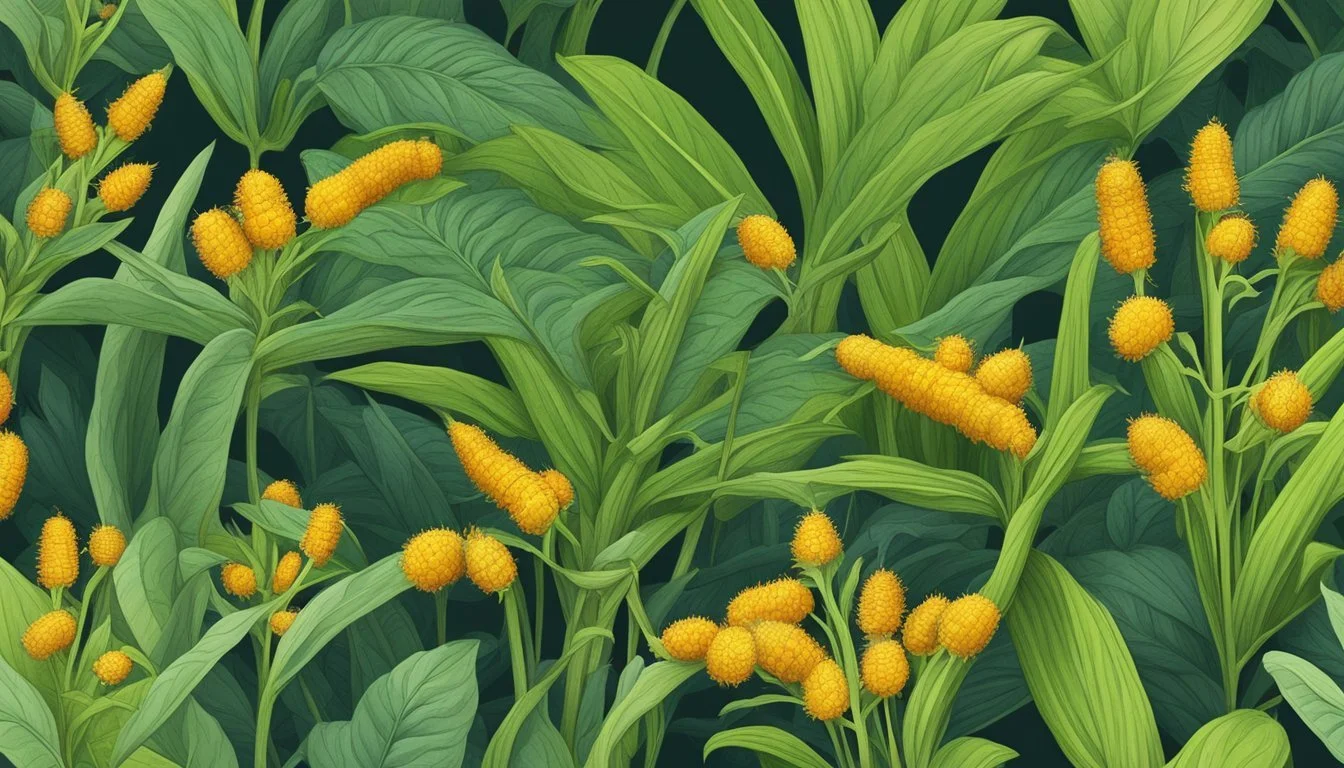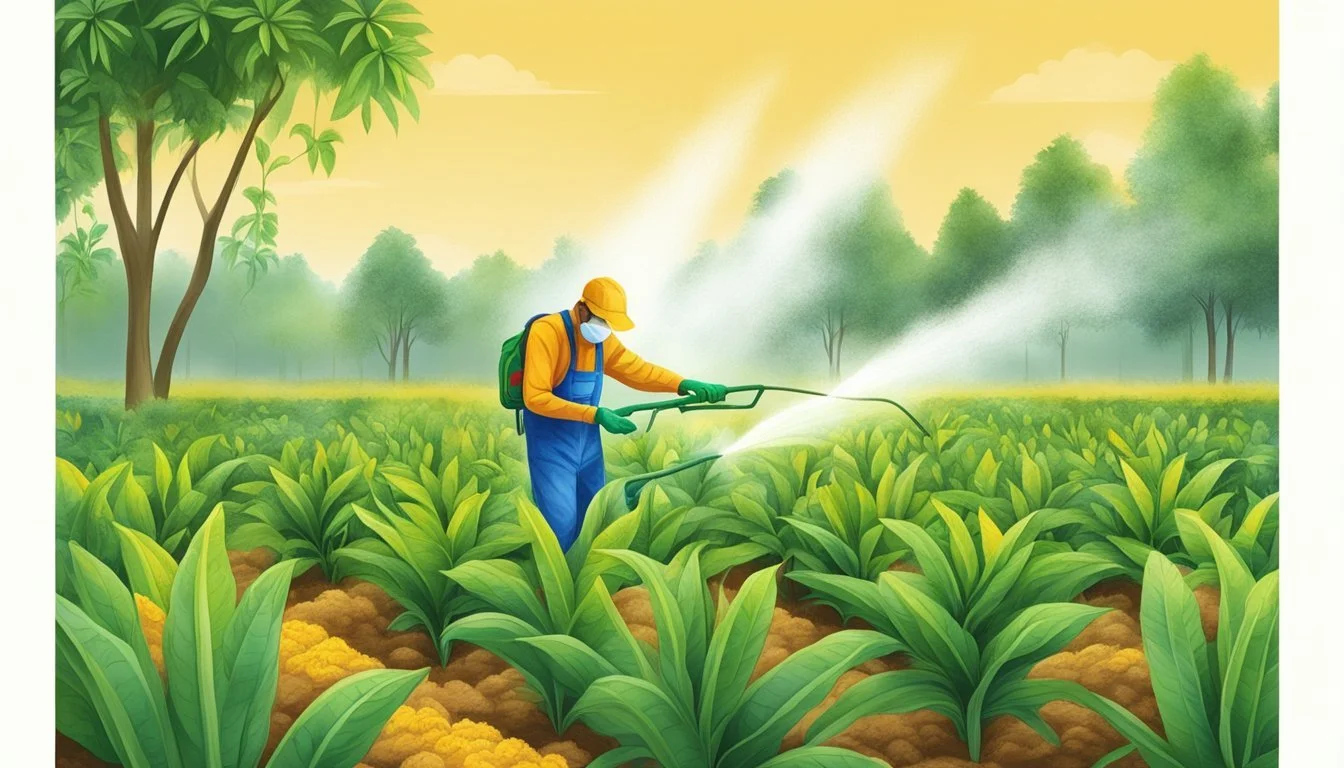Pest Control for Turmeric
Effective Strategies for Protecting Your Crop
Turmeric is a crop revered not only for its culinary uses but also for its medicinal properties, making it a valuable plant for many growers. However, like many crops, turmeric is susceptible to various pests that can affect both the quality and quantity of the harvest. Effective pest control is therefore crucial for ensuring that turmeric plants thrive and produce the vibrant rhizomes for which they are known. While chemical pesticides are commonly used, there's a growing interest in using natural alternatives to protect this spice from pests, thus keeping the turmeric organic and safe for consumption.
There are several methods of pest control that are effective for turmeric. One natural solution involves using turmeric itself as a pesticide. It has been shown to be quite effective in this capacity, especially when combined with other natural substances. For instance, using a combination of turmeric and mustard oil can act as a deterrent against common pests, increasing the level of protection without resorting to synthetic chemicals. In addressing pest management for turmeric, it is crucial to understand the types of pests that typically plague this plant and to identify signs early on to mitigate potential damage to the crops.
By exploring natural pest control options, growers can maintain an eco-friendly approach that safeguards their turmeric crops. It's essential in the process to remain adaptive and vigilant, introducing measures such as beneficial insects, manual removal or natural repellents like turmeric-based pesticides to combat the different insects that may threaten turmeric plants. This integrated approach not only preserves the quality of the turmeric but also contributes positively to the surrounding ecosystem.
Understanding Turmeric Cultivation
Turmeric, known botanically as Curcuma longa, is a perennial herb with notable antioxidant and anti-inflammatory properties, largely attributed to compounds like curcuminoids and turmerones. This section explores the botany and varieties of turmeric, its preferred growing conditions, and the lifecycle of the plant.
Turmeric Botany and Varieties
Curcuma longa is characterized by its underground stem, known as a rhizome, which is the main site for the synthesis of bioactive compounds such as curcuminoids and the fragrant oil component turmerones, including ar-turmerone. Various cultivars exist, each with its unique profile of these compounds. Rhizomes are not only pivotal in the plant's reproduction but are also the harvested part of turmeric used for culinary and medicinal purposes.
Preferred Growing Conditions
Turmeric thrives in a warm, humid climate with well-drained, fertile soil rich in organic matter. The soil's pH should ideally range between 5.5 and 6.5. Adequate rainfall or irrigation is crucial during the growth phase, but drier conditions are preferable as the rhizomes mature. Given these conditions, turmeric plants can achieve optimum growth, leading to the development of high-quality rhizomes abundant in curcuminoids and turmerones.
Turmeric Plant Lifecycle
The lifecycle of turmeric begins with the germination of pre-treated rhizomes planted in the soil. This process usually takes about 7 to 10 days. Post germination, turmeric plants go through a vigorous growth phase where leaves develop and the plant reaches maturity over the course of 8 to 10 months. Post-harvest, the rhizomes can be processed or used to propagate new plants for the next growing season, continuing the turmeric cultivation cycle.
Common Pests in Turmeric Farming
In turmeric farming, pest management is crucial for maintaining healthy crops. Certain insects and soil-borne organisms can cause considerable damage to turmeric plants. Below, we discuss the various pests that can affect turmeric cultivation, including insects, nematodes, and diseases related to pest infestations.
Insect Pests and Their Identification
Aphids: These soft-bodied insects can form colonies on the underside of leaves, stealing sap and weakening plants. They are easily identified by their pear-shaped bodies and can be green, yellow, brown, red, or black.
Thrips: Small, narrow insects known for their rapid movements, thrips scrape at the plant to ingest its contents, resulting in discolored and distorted leaves.
Beetles: Including the rhizome weevil, beetles tend to chew on plant parts, with weevils specifically targeting underground rhizomes, causing direct damage to the turmeric itself.
Whiteflies: These tiny, winged insects are found on the undersides of leaves, and they sap nutrients from the plant, causing stunted growth and promoting the growth of sooty molds due to the sticky residue they leave behind.
Soil-Borne Pests and Nematodes
Nematodes: Microscopic roundworms, like root-knot nematodes, infest the roots, causing swellings or galls that impair the plant's ability to absorb water and nutrients.
Ants are sometimes indicators of a larger pest issue, as they are attracted to the honeydew produced by aphids and other harmful insects, potentially facilitating the spread of these pests across a turmeric farm.
Diseases Associated with Pests
Diseases in turmeric are frequently associated with the presence of pests. For instance, the fungi that cause rhizome rot may be spread by beetles and weevils that carry spores from infected to healthy plants. Moreover, viruses transmitted by pests like aphids can lead to yellowing or mottling of leaves, ultimately reducing the plant's vigor and yield.
Preventive Measures for Pest Management
Effective pest management in turmeric cultivation is vital to prevent infestations that can compromise crop health and yields. Utilizing a combination of cultural practices, biological control methods, and organic strategies can significantly reduce pest populations.
Cultural Practices for Pest Prevention
Crop Rotation: Implementing crop rotation can break the life cycle of pests, effectively reducing their numbers. Rotating turmeric with dissimilar crops like marigolds can deter pests naturally due to the different plant characteristics and needs.
Healthy Planting Materials: It is essential to start with healthy rhizomes that are free from pests. One should inspect and select only the best planting materials to prevent the introduction of rhizome weevils and other pests into the field.
Biological Control Methods
Beneficial Insects: Introducing insects such as ladybugs and parasitic wasps helps control pest populations by preying on harmful pests. This method ensures that the natural pest predators are present to keep the ecosystem balanced.
Microbial Insecticides: Certain microbes like Bacillus thuringiensis can be applied as biological insecticides. They infect and kill specific pests without harming beneficial insects or the environment.
Organic Pest Control Strategies
Neem Oil and Garlic Extracts: Spraying neem oil or garlic extracts can act as an excellent organic deterrent for a range of turmeric pests. These natural substances interfere with the pests' life cycles and deter them from feeding on the turmeric plants.
Barriers and Traps: The use of physical barriers such as nets can prevent pests such as whiteflies from reaching the plants. Similarly, pheromone traps attract and capture pests, reducing their populations effectively.
By integrating these preventive measures into turmeric farming practices, growers can protect their crops from common pests, leading to a healthier harvest without the need for commercial pesticides.
Chemical and Non-Chemical Treatments
Proper management of pests in turmeric cultivation involves a range of treatments. Decisions on treatment typically factor in effectiveness, environmental impact, and safety for consumers. Below, insecticides and organic alternatives are discussed, alongside their application methods.
Insecticides and Fungicides
Insecticides are chemical substances used to kill insects, crucial in managing infestations that can threaten turmeric crops. One such chemical is mancozeb, a protective fungicide effectively used to combat fungal diseases in turmeric. Chemical treatment should only be applied as per the labelled instructions to ensure safety and effectiveness.
Alternative Treatment Options
For cultivators who prioritize eco-friendly methods, neem oil and insecticidal soap offer natural alternatives to synthetic chemicals. Neem oil acts as an antifeedant and growth disruptor for many pests, while insecticidal soap can be used to target soft-bodied insects like aphids and whiteflies, ensuring minimal impact on the environment and beneficial insects.
Application Techniques
Efficient application of both chemical and non-chemical treatments is critical for their success. Treatments can be applied using sprayers, ensuring thorough coverage of the turmeric plants. Emphasis is placed on the precise dosage and timing of applications to align with pest life cycles and minimize the risk of developing resistance.
Monitoring and Managing Pest Populations
Effective pest control in turmeric cultivation hinges on understanding pest population dynamics and the influence of weather conditions on pest occurrences. Bringing these elements together through Integrated Pest Management can sustainably reduce crop losses.
Pest Population Dynamics
Turmeric is susceptible to a variety of pests that can cause significant damage throughout the growing season. Pest populations tend to fluctuate, impacted by numerous factors including crop stage, availability of food, and interactions with other species. It is critical for farmers to regularly monitor pest populations to ensure early detection and management. Between July to October, pests are particularly active, necessitating vigilant surveillance during these months.
Insect pests cause substantial losses to food and fiber crops worldwide. Integrated pest management originated almost 60 years ago as a response to the negative impacts of pesticide dependencies.
Weather-Related Pest Occurrences
Temperature and humidity play pivotal roles in the life cycle of pests. During July to October, the temperature and moisture levels could lead to an uptick in pest activity. Farmers should adjust their monitoring schedules based on the predicted weather patterns to anticipate and combat pest proliferation effectively.
Monitoring ensures that growers are finding pest populations when they are smallest and most manageable, making it easier to deal with them effectively.
Integrated Pest Management
Integrated Pest Management (IPM) is a strategic approach that combines multiple techniques for pest control. It encompasses regular monitoring to identify and manage pest populations, the use of biological control agents, and targeted applications of pesticides when necessary. IPM emphasizes the use of environmentally friendly methods and is particularly suited to managing pests in turmeric, as it helps to minimize the emergence of pesticide resistance and preserves the quality and safety of the crop.
Insect pests affect all forms of agricultural production, from densely planted field crops to high-value nursery plants to grains in storage.
Post-Harvest Pest Management
Post-harvest management of turmeric is critical to prevent infestation and ensure the quality of the spice remains high. Proper handling of infected rhizomes and the methods employed to control storage pests are essential steps to retain the health benefits and flavor of turmeric.
Storage Pests and Their Control
Storage pests can severely damage turmeric by attacking the dried rhizomes, leading to loss in both quantity and quality. The most effective strategy is to remove and destroy infected rhizomes before storage. This helps to curb the spread of pests. Technologies such as hermetic storage can also limit pest access and preserve the turmeric's qualities.
For instance, the Integrated Pest Management guidelines suggest practices to protect turmeric against pests like the cigarette beetle, which is known to infest stored rhizomes. Various techniques are recommended, ranging from using botanical pesticides to adopting proper sanitation measures, to maintain the integrity of the stored spice.
Maintaining Product Quality
The quality of stored turmeric directly affects its health benefits and flavor. It is imperative to control environmental factors like humidity and temperature during storage. Turmeric should be stored in cool, dry places to prevent fungal growth which can lead to contaminated rhizomes.
Moreover, the application of food-safe pesticides or fumigants may be necessary to address the challenge of infestation. Their use, however, should be as per the safety norms to ensure that the health benefits of turmeric are not compromised. Regular inspection of stored turmeric for any signs of pest damage is a key component of maintaining high-quality standards.
Through diligent post-harvest pest management, the integrity and purity of turmeric can be preserved, ensuring it remains a safe and beneficial addition to food across the globe.
Impacts of Pest Control on Turmeric Quality
Effective pest control in turmeric cultivation is critical to ensure the quality of the final produce. Pests like shoot borers can cause significant damage to turmeric plants, leading to a reduction in the quality of turmeric rhizomes. The use of appropriate pest management strategies can preserve the integrity of turmeric, which is lauded not only for its culinary uses but also for its curcumin content, a compound known for its antioxidant and anti-inflammatory properties.
The application of suitable pest control methods can have the following impacts on turmeric quality:
Curcumin Levels: Maintaining healthy turmeric crops free from pests supports optimal levels of curcumin, which contributes to the rhizome's medicinal value.
Color: Pest-free turmeric tends to exhibit a more vibrant color, a key quality attribute associated with purity and potency.
Flavor: The absence of pests ensures that the plant's flavor profile remains untarnished, as pests can introduce unwanted flavors and reduce the aromatic quality.
Nutritional Value: Effective pest management helps in preserving the essential vitamins and minerals that contribute to the nutritional benefits of turmeric.
When discussing pest control measures, it is important to consider both synthetic and natural options. Synthetics might offer immediate results but could diminish turmeric's quality and vitality through potential chemical residues. Conversely, organic pest controls support the cultivation of high-quality turmeric and align with sustainable agricultural practices.
In summary, the chosen pest control approach for turmeric can directly affect the quality of the yield. By ensuring that pest levels are kept in check, farmers can protect the plant's valuable properties, resulting in turmeric that meets the high expectations for flavor, color, and health benefits.
Economic and Environmental Considerations
In the cultivation of turmeric, both the economic viability of pest control measures and their environmental impact are critical factors that need to be balanced for sustainable agriculture practices.
Cost-Effectiveness of Pest Control Strategies
It's important to evaluate the economic efficiency of pest control strategies in turmeric farming. Commercial pesticides often present a significant cost to farmers, but they may lead to a higher yield by effectively controlling pests. On the other hand, organic pest control methods, while potentially less harmful to the environment, might require more labor-intensive practices or may not be as immediately effective, impacting the overall cost-effectiveness.
Commercial Pesticides:
Initial costs can be high.
May lead to increased yields and reduced crop loss.
Organic Pest Control:
Lower initial investment.
Potential for reduced yield if pest control is less effective.
Environmental Impact of Pest Control
The use of commercial pesticides often raises concerns about environmental safety. These pesticides can sometimes lead to soil degradation and water pollution, impacting local ecosystems. In contrast, organic pest control methods emphasize the health of the environment, relying on natural predators or plant-based products, reducing potential negative effects on the environment.
Commercial Pesticides:
Can cause soil and water pollution.
Risk of harming non-target species.
Organic Pest Control:
Minimizes ecological footprint.
Supports biodiversity by encouraging beneficial organisms.
Frequently Asked Questions
In addressing pest management for turmeric, it's crucial to understand the natural methods available, the pests commonly affecting turmeric plants, and the symptoms of infestations such as nematodes.
How can turmeric be used to manage pests naturally?
Turmeric can manage pests through its natural compounds, which can be formed into homemade pesticides and insecticides. Its effectiveness increases when combined with other substances like mustard oil.
What are the common pests affecting turmeric crops?
Aphids and whiteflies are common pests that affect turmeric plants. They can be managed by physical removal or using natural predators like ladybugs.
Which methods are effective in controlling thrips in turmeric?
Effective methods to control thrips include the use of neem oil or introducing beneficial insects that prey on these pests.
What symptoms indicate nematode damage in turmeric plants?
Symptoms of nematode damage in turmeric can include stunted growth, yellowing of leaves, and the development of galls or knots on the roots.
Can turmeric act as an insect repellent for other crops?
Turmeric has properties that can deter insects, and therefore, it can potentially act as an insect repellent for other crops when used in companion planting or as a natural pesticide.
What are the best practices for storing turmeric powder to prevent insect infestation?
To prevent insect infestation in stored turmeric powder, ensure the storage area is dry, airtight, and possibly include natural repellents like neem leaves to deter pests.






